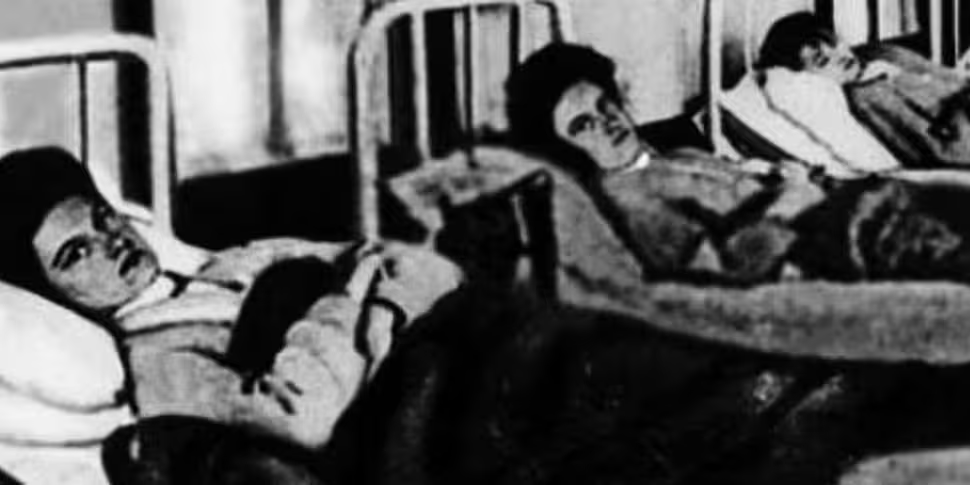100 years ago today, Mary Mallon, known the world over as ‘Typhoid Mary’, was quarantined in New York for the second time. An asymptomatic carrier of the typhoid virus, who could not understand how her generally healthy disposition could possibly be infecting (and killing) members of the wealthy families for whom she cooked, this immigrant to the US had left Ireland alone at the age of 14, and the rest of her lifetime would be marked by extended periods of isolation.
It is believed she infected 47 people, three of whom died, though she never showed signs of the disease herself.
On today’s Right Hook, George talks to American historian Judith Walzer Leavitt, about her book Typhoid Mary: Captive to the Public's Health, to find out more about the enigmatic Irish woman, whose life was plagued by disease, death, and loneliness. Tune in live at 6.20pm: http://www.newstalk.com/player/
Not much remains of her thoughts during her 26 years of quarantine, which only ended with the end of her life, and it is hard to form a picture of her plight and mental state during this time. In 1909, halfway through her first period of quarantine (against her will on an Island in New York City’s East River), she wrote a letter to an editor of an American newspaper – before scratching that out and readdressing it to her attorney.
This letter, published below, gives some impression of a woman completely bewildered by her situation – a seemingly healthy woman named and shamed as a deadly carrier of typhoid, effectively incarcerated by public health officials who saw no alternative. The letter reveals her obstinate character, her spitefulness, as well as her palpable frustration with her quarantine, and the loneliness she’d would never escape.
George Francis O'Neill
To the Editor of the American
In reply to Dr. Park of the Board of Health I will state that I am not segregated with the typhoid patients. There is nobody on this island that has typhoid. There was never any effort by the Board authority to do anything for me excepting to cast me on the island and keep me a prisoner without being sick nor needing medical treatment. When I first came here they took two blood cultures, and feces went down three times per week, say Monday, Wednesday, and Friday, respectively, until the latter part of June. After that they only got the feces once a week, which was on Wednesday. Now they have given me a record for nearly a year for three times a week.
When I first came here I was so nervous and almost prostrated with grief and trouble. My eyes began to twitch, and the left eyelid became paralyzed and would not move. It remained in that condition for six months. There was an eye specialist [who] visited the island three and four times a week. He was never asked to visit me. I did not even get a cover for my eye. I had to hold my hand on it whilst going about and at night tie a bandage on it.
In December when Dr. Wilson took charge, he came to me and I told him about it. He said that was news to him and that he would send me his electric battery, but he never sent [it]. However, my eye got better thanks to the Almighty God and no thanks in spite of the medical staff. Dr. Wilson ordered me urotropin. I got that on and off for a year. Sometimes they had it, and sometimes they did not. I took the urotropin for about three months all told during the whole year. If I should have continued [it], it would certainly have killed me for it was very severe. Everyone knows who is acquainted in any kind of medicine that it's used for kidney trouble.
When in January [1908] they were about to discharge me, when the resident physician came to me and asked me where was I going when I got out of here, naturally I said to N.Y., so there was a stop put to my getting out of here. Then the supervising nurse told me I was a hopeless case, and if I'd write to Dr. Darlington and tell him I'd go to my sisters in Connecticut. Now I have no sister in that state or any other in the U.S. Then in April a friend of mine went to Dr. Darlington and asked him when I was to get away. He replied "That woman is all right now, and she is a very expensive woman, but I cannot let her go myself. The Board has to sit. Come around Saturday." When he did, Dr. Darlington told this man "I've nothing more to do with this woman. Go to Dr. Studdiford."
He went to that doctor, and he said "I cannot let that woman go, and all the people that she gave the typhoid to and so many deaths occurred in the families she was with." Dr. Studdiford said to this man "Go and ask Mary Mallon and enveigle her to have an operation performed to have her gallbladder removed. I'll have the best surgeon in town to do the cutting." I said "No. No knife will be put on me. I've nothing the matter with my gallbladder." Dr. Wilson asked me the very same question. I also told him no. Then he replied "It might not do you any good." Also the supervising nurse asked me to have an operation performed. I also told her no, and she made the remark "Would it not be better for you to have it done than remain here?" I told her no.
There is a visiting doctor who came here in October. He did take quite an interest in me. He really thought I liked it here, that I did not care for my freedom. He asked me if I'd take some medicine if he brought it to me. I said I would, so he brought me some Anti Autotox and some pills then. Dr. Wilson had already ordered me brewer's yeast. At first I would not take it, for I'm a little afraid of the people, and I have a good right for when I came to the Department they said they were in my [intestinal] tract. Later another said they were in the muscles of my bowels. And latterly they thought of the gallbladder.
I have been in fact a peep show for everybody. Even the interns had to come to see me and ask about the facts already known to the whole wide world. The tuberculosis men would say "There she is, the kidnapped woman." Dr. Park has had me illustrated in Chicago. I wonder how the said Dr. William H. Park would like to be insulted and put in the Journal and call him or his wife Typhoid William Park.
Mary Mallon









